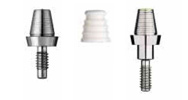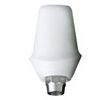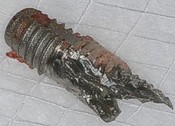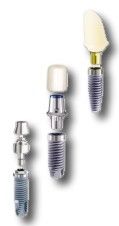Dynamics of Dental Implant Failure
Long Island Reconstructive Dentistry

Dental Implant Parts
Most implants placed today are root form implants.
Root form implants problems can be classified as ailing, failing, or failed:
- Failed implant – if the implant has any mobility the only acceptable treatment is removal
- Failing implant – if checkup x-rays show increased bone loss around the top of the implant, the cause must be determined and corrected. The cause could be poor oral hygiene, a bad bite or a host of other reasons. After correcting the problem the resorbed bone should be grafted
- Ailing implants – the least severe of the three categories. Any signs of inflammation, redness or mild bone loss may be signs that the implant is not completely healthy.
Loosening Implant Failures

Zirconia Abutment
A patient’s report of a loose implant can be a relatively minor issue that might involve a loosening abutment or a simple cementation process that has gone awry. It can also be a symptom of something that might be an alert that something more serious might be underway which really should be investigated immediately.
Preliminary Diagnosis ASAP
As a general rule, treating any kind of loose tooth symptom shouldn’t be delayed any longer than necessary. It is difficult to predict what events will occur or are occurring elsewhere in the dentition.
An implant that feels like it is loosening, rotating or wiggling around could be a sign of an osseointegration failure or an infection issue. Unknowingly this could prove to be disastrous for surrounding tissues.. if indeed the implant itself is loose.
Broken or fractured implant screws: The crown or abutment are attached to the implant by a screw. If the screw is fractured it must be properly removed to prevent damage to the implant.
Osseointegration Failure:
Unfortunately, a popular cause of implant failure if certain protocols are not followed closely. Optimal integration of the implant device into the jawbone requires an acceptable level of healthy bone (porosity values + ample blood supply), matching of implant size to location in jaw, proper site preparation and suitable bone augmentation (bone grafts) deemed necessary.
Osseointegration can also fail due to premature loading of the implant restoration. It is generally accepted that osseointegration can require 3-6 months or more, depending on preoperative oral health conditions.
Improper implant placement:
The implant is placed in an area that is unrestorable. A special trephine drill is available for most major implant systems to remove the implants. The drill is razor thin and fits on the outside of the implant. It is irrigated from the inside. This prevents additional bone loss and the irrigant reduces the overheating of the bone. They are very expensive drills, however they are the “kindest” to the tissue.

Damaged Implant
Fractured implants:
Using the wrong type, size, quantity, position or length of implant, thereby causing over loading, may result in implant failure. To preserve integrity of bone, it is imperative that the fractured implant be removed as atraumatically as possible.
Fractured abutments:
The principle concern is to maintain the health of the implant. In some cases the abutment may simply require a new screw. Other cases may necessitate remaking the abutment and/or crown.
Bad Implant Summary
Unlike a loose crown or cap, a loose or slipping veneer, poorly fitting denture or partial…. an undiagnosed loose dental implant can become destructive almost immediately, depending upon the cause of the “looseness.” Like a tent stake that is firmly hammered into the ground, a few lateral or sideways forces that impact an implant can make the implant device wobble repeatedly, eventually loosening within the bone and then destroying the osseointegration of the implant.
When it is known that the crown and/or abutment is loose and not the implant device (housing), removal of the loose part(s) can prevent potential damage to the osseointegrated implant. In cases where the implant device is indeed loose, the treatment typically consists of replacing the implant device with or without bone graft material.
Emergency Diagnostics
Patients who suspect they have a loose implant restoration or dental implant are welcome to contact our office on an emergency basis to prevent additional damage and/or bone loss.
Patients seeking additional information or details about specialized treatment sessions or appointments are invited to contact Dr. Brant directly via our on-line Ask The Dentist form during or after usual business hours.
Call: 631.584.4395
Dr. Brant can provide examples of how executives from a variety of industries and institutions are provided with a custom utilization of our services to deliver treatment outcomes for nearly any kind of time schedule.

